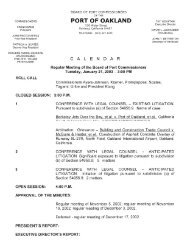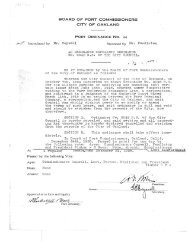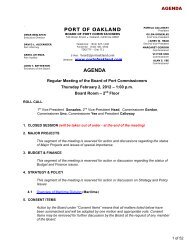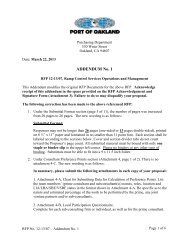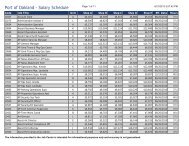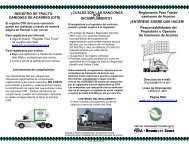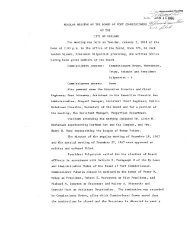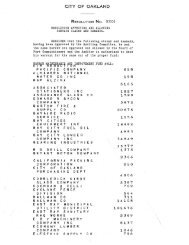Port-Wide Sewer System Management Plan(SSMP) - Port of Oakland
Port-Wide Sewer System Management Plan(SSMP) - Port of Oakland
Port-Wide Sewer System Management Plan(SSMP) - Port of Oakland
You also want an ePaper? Increase the reach of your titles
YUMPU automatically turns print PDFs into web optimized ePapers that Google loves.
Chapter 8<br />
FOG CONTROL PLAN<br />
This chapter summarizes the <strong>Port</strong> <strong>of</strong> <strong>Oakland</strong> (<strong>Port</strong>) fats, oil, and grease (FOG) control<br />
program, which has been developed to limit the amount <strong>of</strong> FOG that enters the collection<br />
system to the extent feasible.<br />
8.1 REGULATORY REQUIREMENTS<br />
8.1.1 San Francisco Bay Area RWQCB Requirements<br />
The San Francisco Bay Area Regional Water Quality Control Board (RWQCB) requires that<br />
each wastewater collection system agency shall evaluate its service area to determine<br />
whether a FOG control program is needed. If so, a FOG control program shall be<br />
developed as part <strong>of</strong> the <strong>SSMP</strong>. If an agency determines that a FOG program is not<br />
needed, the agency must provide justification for why it is not needed.<br />
8.1.2 SWRCB Requirements<br />
State General Waste Discharge Requirements Order No. 2006-0003 (GWDRs), issued by<br />
the State Water Resources Control Board (SWRCB), specifies that this <strong>SSMP</strong> must include<br />
an evaluation <strong>of</strong> the <strong>Port</strong> service area to determine whether a FOG control program is<br />
needed. If no FOG program is needed, justification for why it is not needed must be<br />
provided. If FOG is considered to be a problem, a FOG source control program must be<br />
prepared and implemented, including the following as appropriate:<br />
a. An implementation plan and schedule for a public education outreach program<br />
that promotes the proper disposal <strong>of</strong> FOG;<br />
b. A plan and schedule for the disposal <strong>of</strong> FOG generated within the sanitary<br />
sewer system service area. This may include a list <strong>of</strong> acceptable disposal<br />
facilities and/or additional facilities needed to adequately dispose <strong>of</strong> FOG<br />
generated within a sanitary sewer system service area;<br />
c. The legal authority to prohibit discharges into the system and identify measures<br />
to prevent SSOs and blockages caused by FOG;<br />
d. Requirements to install grease removal devices (such as traps or interceptors),<br />
design standards for the removal devices, maintenance requirements, Best<br />
<strong>Management</strong> Practice (BMP) requirements, record keeping and reporting<br />
requirements;<br />
e. Authority to inspect grease producing facilities, enforcement authorities, and<br />
whether the Enrollee has sufficient staff to inspect and enforce the FOG<br />
ordinance;<br />
f. An identification <strong>of</strong> sanitary sewer system sections subject to FOG blockages<br />
and establishment <strong>of</strong> a cleaning maintenance schedule for each section; and<br />
g. Development and implementation <strong>of</strong> source control measures for all sources <strong>of</strong><br />
FOG discharged into the sanitary sewer system for each section identified in (f)<br />
above.<br />
May 2010 8-1<br />
pw://Carollo/Documents/Client/CA/<strong>Port</strong> <strong>of</strong> <strong>Oakland</strong>/8239A00/Deliverables/Ch08 (FinalA)



